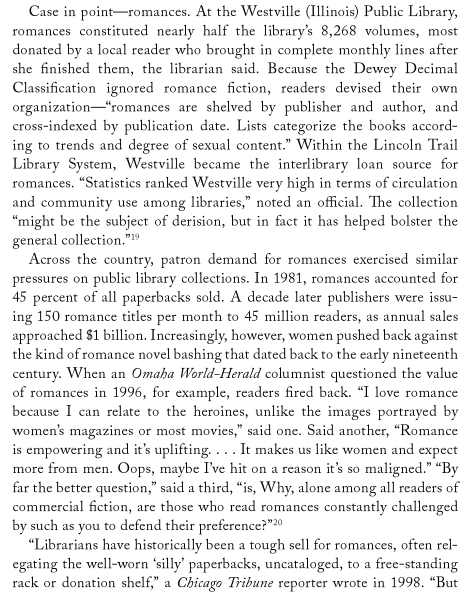Page 229 of Wayne A. Wiegand's Part of Our Lives: A People's History of the American Public Library (New York, NY: Oxford UP, 2015) focuses on romance fiction. The excerpt below begins by drawing on a 1983 article in the New York Times:

Here are the end notes:

Following up on them, I think I found some things which were of just as much, if not more, interest than the details quoted by Wiegand.
The New York Times article on "Written Romance in the Stacks" from 1983 is available online here. It's significant that at Westville:
''We keep the collection primarily because it's very popular with the people, the ladies especially,'' says Shirley Moretto, the head librarian. ''We figure that if we get them in to read those, eventually they'll read the other books, too.''
She sounds like a parent trying to sneak some pureed vegetables into the diet of a picky toddler.
An admission of librarian cluelessness can be found in the 1998 Chicago Tribune article (available online - page 1 and page 2):
"We have changed our tune here at the library," said Vivian Mortensen, head of reader services at Park Ridge Public Library, near Chicago. "We used to feel that (romance readers) were sheltered housewives. But we find that many businesswomen read them, and every kind of person, from grandmothers to young mothers. We were thinking that this was a small group of people interested in this, and it's not. There are a lot of women out there who love them, and a few men. Some of my librarian friends say this is their favorite type of reading."
The Chicago-Tribune article on "The Color of Passion is Mostly White" from 1983 is available online here and it's worth reading in full. Here's an excerpt:
ethnic romances never gained momentum, despite the fact that Harlequin, the world's leading publisher of romances, estimated that 25 percent of its subscriptions went to blacks. [...]
Second Chance at Love, a division of Jove publishers, recently shelved plans for an ethnic line. " It was really a distribution problem," said senior editor Ellen Edwards. "If it were a strictly ethnic line, say black, we would have to distribute it only in certain bookstores."
In other words, Jove's management decided that the general readership would not accept ethnic romances.[...]
Editors, writers and readers offer various reasons for the failure of ethnic romances
One of those reasons is that the black romances were allegedly "missing [...] some flavor of the black experience" even though, as one AA author observed, they did reflect her experiences:
"My characters are college educated, professionally successful and well-rounded; they are the kind of people I know," said Stephens, who holds a masters degree from Harvard. "I wanted black characters, but the book is not about the black experience and struggle."
All of which seems to suggest that there was resistance to seeing black characters who were successful both professionally and in their personal lives.
